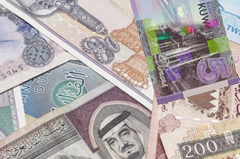DUBAI: The private sector in the two biggest Gulf Arab economies grew at the slowest pace in years in October, corporate surveys showed yesterday, indicating low oil prices are starting to slow business activity across the region. The seasonally adjusted Emirates NBD Saudi Arabia Purchasing Managers' Index for last month dropped to 55.7, its lowest level since the survey began in August 2009, when the world's top oil exporter was grappling with the global financial crisis.
The equivalent index for the United Arab Emirates, which measures growth in private manufacturing and services excluding oil, fell to a 30-month low of 54.0.
Until the last few months, heavy government spending in the region's six wealthy oil states insulated them from low oil prices. Government revenues shrank, but they dug into huge financial reserves to keep pouring money into their economies.
But the latest data suggest economies are no longer escaping damage from cheap oil. Faced with the possibility of many years of budget deficits if oil prices do not recover, governments have started to tighten fiscal policy, delaying or suspending expenditure on projects they consider non-essential.
At the same time, monetary conditions are tightening even though central banks in the region want to keep them loose. Less new oil money is flowing into commercial banks, while some governments including Riyadh are issuing bonds to banks to fund their budget deficits.
The result is rising market interest rates the three-month Saudi interbank rate has climbed 20 basis points in the last three months. The trend may accelerate if the United States begins raising interest rates in coming months. Another source of monetary tightening is the currency peg Gulf countries maintain with the US dollar. The dollar's strength is weighing on non-oil exports and tourism in countries where those sectors are important, such as the UAE.
"Talk of austerity in Arabia sounds ridiculous but it is increasingly certain that next year will see a slowdown in economic activity due to the double whammy of tightening fiscal and monetary policies," Tarek Fadlallah, chief executive of Nomura Asset Management Middle East, wrote in a report.
"With budget deficits swelling and foreign currency reserves shrinking, governments have indicated that they will trim spending and the private sector has started to lower its capital investment accordingly."
GDP
The purchasing managers' indexes for both Saudi Arabia and the UAE remain well above the 50-point mark which separates growth from contraction, so at this stage, few people expect recessions in the Gulf. A Reuters poll of 24 economists, conducted in mid-October, predicted Saudi gross domestic product growth would ease to a median 2.5 percent next year from 3.0 percent this year. Growth in the UAE is seen edging down to 3.3 percent from 3.5 percent.
There are several threats to this optimism. GDP growth has been inflated this year by rising oil output in the Gulf; output may abruptly stop increasing next year as the market becomes saturated and sanctions on major producer Iran are lifted.
Many economists are assuming oil prices will begin a gradual recovery next year. If they do not, governments may be pressured into bigger spending cuts than expected. With giant financial reserves compared with the size of its population and a diversified economy, the UAE could still cope fairly comfortably. Saudi Arabia, with more people and bigger fiscal commitments, would be in a more difficult position.
The kingdom's central bank, which serves as its sovereign wealth fund, has burned through $90 billion of foreign assets since August 2014 as it raises money to pay the government's bills. It still has $647 billion, but would have to halt the decline well before reaching zero to avoid a market panic.
So far this year, the Saudi economy has been supported by strong consumer spending. Third-quarter turnover at Jarir Marketing, one of the largest Saudi retailers by market value, rose 7.7 percent from a year earlier. "We have lived this three or four times before since 1980 - we are not concerned by negative sentiment," Jarir Chairman Muhammad Al-Agil said last week at a Reuters summit on Middle East investment, referring to the drop in oil prices.
"What could happen? Seventy to 80 percent of Saudis work for the government, and the government is not going to change its payroll." But consumer behavior could start to change if the government makes spending cuts that hurt disposable income - for example, raising heavily subsidized domestic gasoline prices, or slowing the rise of public-sector wages. It has said it is considering both steps. One statistic which economists see as a rough indicator of Saudi consumer spending intentions is the volume of cash withdrawals from automated teller machines. It fell from a year earlier in September for the first time this year. - Reuters











